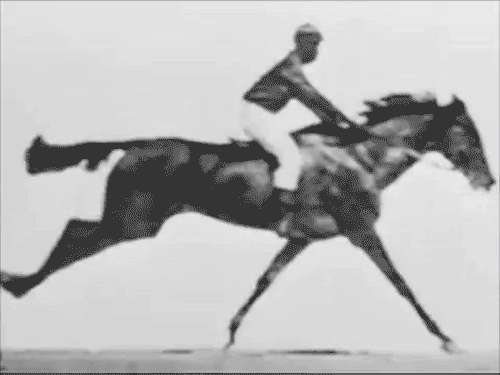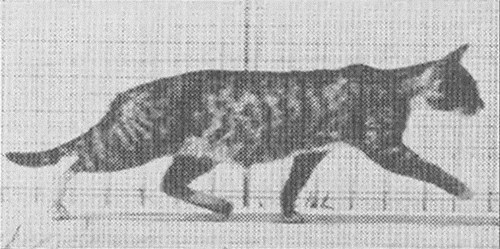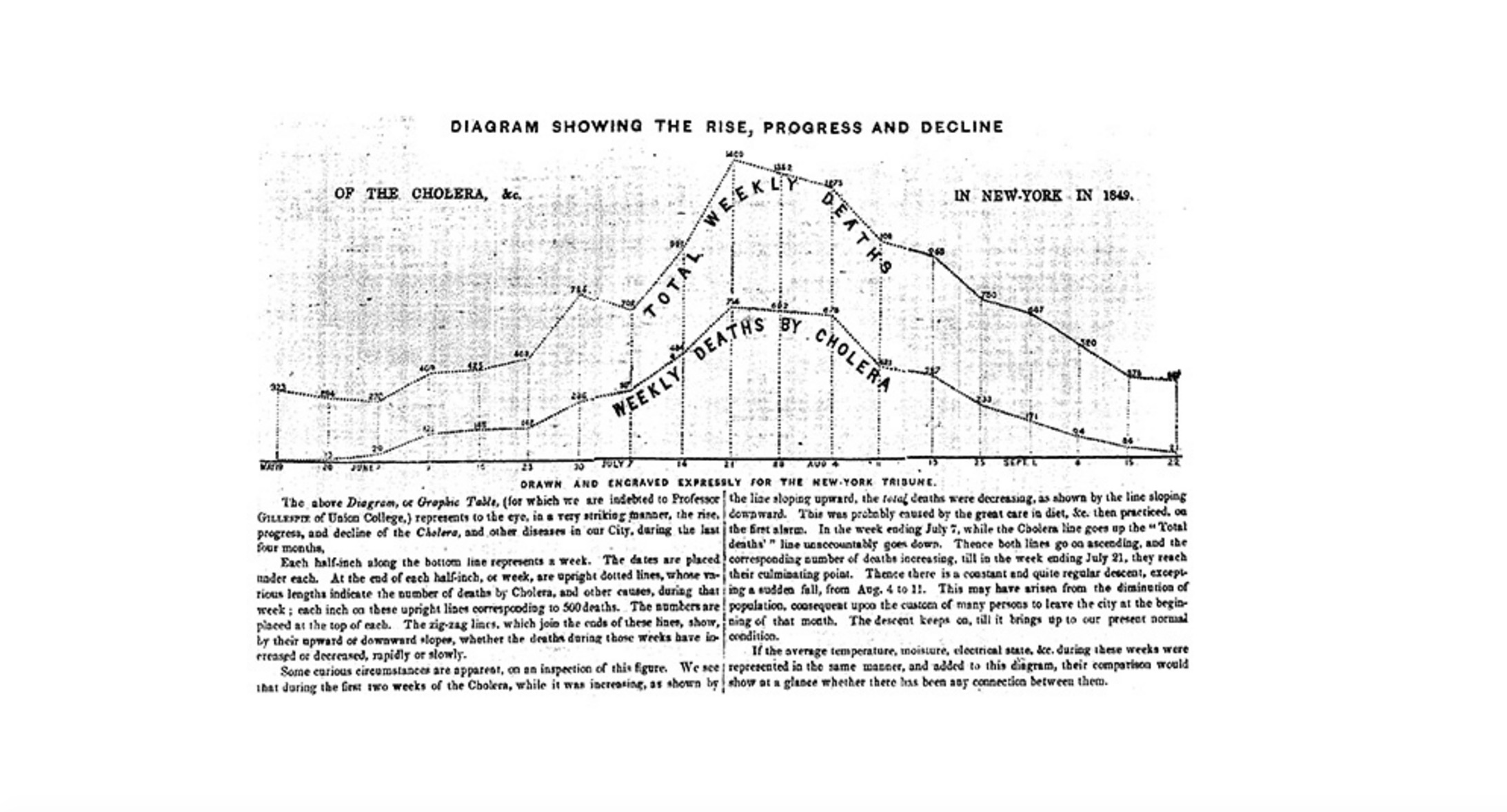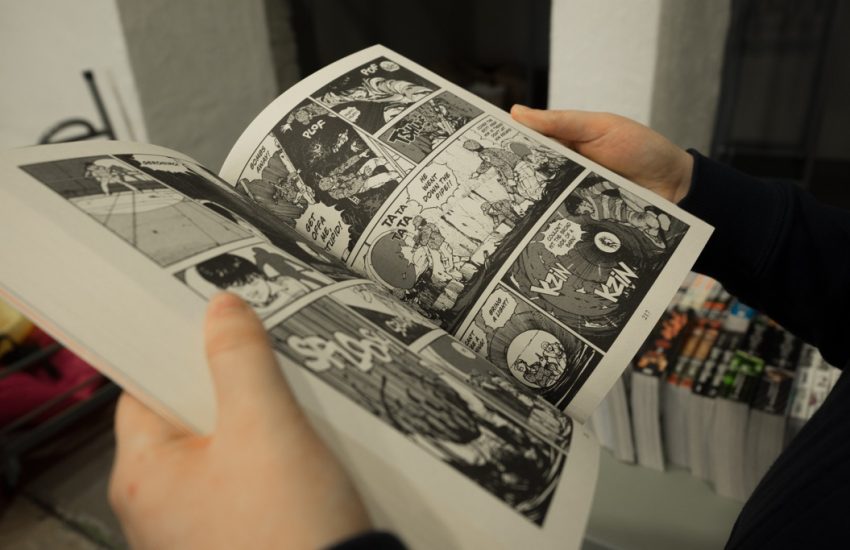What history can tell us about the future of interactive journalism
Robin Kwong is Special Projects Editor at the Financial Times where he runs newsroom experiments and helps coordinate large-scale coverage.
I’ve been thinking a lot recently about historical progress, cycles and how they relate to what we are trying to do with visual and digital storytelling today.
It all started with annotations. Specifically, the 300-odd words of text beneath this line chart from 1849 that was unearthed by Scott Klein. In this text, the New York Tribune writer doesn’t just describe in detail the information the chart was meant to convey. He also guides the reader on how to read the chart and what conclusions to draw from it:
1850's newspapers didn't really publish charts. @kleinmatic explains why. https://t.co/RSGxk8UN4a pic.twitter.com/sUlxYis3vu
— Aleszu Bajak (@aleszubajak) March 27, 2016
It is clumsy and heavy-handed. The writer was trying to introduce a new form of storytelling enabled by technological changes and there is a tension between the vision of this new, more efficient form of storytelling versus the practical need to explain (perhaps even over-explain) it in an old, familiar format. The end result was not ideal, but it was a necessary and important step in establishing the aesthetics of data visualization.
The parallels with what we are now trying to do with the digital presentation of journalism are clear. We, too, are groping our way towards a new aesthetic. But instead of printed graphics, our new form uses a combination of text, code, graphics, audio, photos, videos or animation to create something akin to what Frank Chimero described as ‘flux’ in What screens want.
For ease of reference, I’m going to use ‘interactive news’ as a shorthand to describe this as yet ill-defined new form through the rest of this piece, even though it is by no means a perfectly apt term.
Like the writer in Scott’s example, we are trying to contextualize and explain interactive news using familiar terms and metaphors. Often in equally clumsy ways. (Granted, some of us do so with greater elegance: See Gregor Aisch’s NICAR16 lighting talk, and this example of exactly the sort of thing he was extolling).
More than 166 years after the New York Tribune chart, line and bar charts are now more likely to be seen as tyrannical standards rather than a novelty.
The longer a visualization exists, the probability someone says it should've been a line/bar chart approaches 1 https://t.co/Zein7whKnU
— Meagan Longoria (@MMarie) April 2, 2016
It has also spawned new forms. Note the heavy use of annotations here:
Nice annotations on this connected scatterplot. Also a little walk-through. https://t.co/54XTveEkNs pic.twitter.com/llUokRrm64
— Robert Kosara (@eagereyes) March 31, 2016
It is tempting to see this as a march of progress that leads to ever-greater literacy and sophistication in visual journalism. Instead, I am struck by the prospect that we might simply be repeating past historical cycles.
At this year’s NICAR and Malofiej conferences, two different strands of thought emerged about the future direction of interactive news. One was Gregor’s call to arms to produce works that derives value uniquely from their interactivity.
The second came broadly from Archie Tse and Lena Groeger’s talks at Malofiej. Archie’s rules for visual storytelling and Lena’s coining of the ‘rhetorical scroll’ both emphasized how and when interactivity (in its broadest sense) should be used in the service of storytelling.
I do not wish to set these two stances against each other as mutually exclusive or in opposition. Instead, I think they represent two different approaches to interactive news.
But we have been here before. Think games. In the late 1990s and through much of the 2000s, the academic study of games broadly followed the same contours: one approach, called narratology, considered games as primarily storytelling devices and sought to place it among other narrative media like movies and novels. The other, broadly termed ludology, disagreed. It considered games rooted in the design of rules. Ludologists like Jasper Juul therefore believed that it is wrong to judge games through traditional narrative theories and instead argued for a separate theory of games in What computer games can and can’t do:
We need a theory that isn’t just interactive bits and pieces tacked on to narratology or dramaturgy. We lack a theoretical understanding of what games are and can, and how they relate to the narrative media such as the novel or the movie. We lack the tools to evaluate and place a computer game both historically and in relation to other games.
A similar discussion is taking place among interactive documentary makers. In Point of View magazine, Sergeo Kirby wrote about ‘The Interactive Paradox’ from a narratological standpoint. Brett Gaylor responded with a response that will be familiar to ludologists: “Bullshit. While interactive documentary is still in its infancy, it contains the potential for the entire range of human emotions and storytelling. The formal categories that Kirby listed are only his own, and don’t bear scrutiny to the diversity and innovation that is occurring within the field.”

It is useful to think of news in terms of art. Ambitious, original pieces of journalism often are testimonies to historical moments. Their goal is not just to provide information, but also to interpret the world and provide a directed experience to its audience — goals shared by works of art. The two are not completely identical, of course. Journalism has an explicit obligation to provide fact-based information that art doesn’t always have.
The main benefit of thinking of news as art is that we can draw on a rich history of philosophical thought about the impact of digital disruption.
In 1936, the growing popularity of film prompted Walter Benjamin to consider The Work of Art in the Age of Mechanical Reproduction. In particular, the socio-political implications of how reproducing works of art destroys the ‘aura’ attached to the original.
In 1972, the growing popularity of the camera prompted John Berger to revisit and update Walter Benjamin’s theories, in Ways of Seeing. Reproduction destroys the authority of art, Berger argues, but it also creates a new language of images that could define our experiences and confer a new kind of power.
What, then, does our age of digital and socially-driven reproduction imply for the pieces of journalism we produce, and more broadly, for our ability to establish interactive news as a new aesthetic?
In the pre-digital age, there was an aura attached to ambitious, original pieces of journalism. The scoop was fetishized; its power derived from its originality and limited availability (and, of course, its quality). But unlike the advent of films or cameras, digital reproduction and social media do not just destroy that aura. It subverts it: A work’s authority — its aura — now derives precisely from its reproduction and being shared. A tree falling in the woods with no one around to video it on Facebook Live no longer makes a sound. Scoops that are not aggregated or shared have little impact.
If interactive news is to become a new aesthetic, it cannot be ignorant of, or stand apart from, this new dynamic. But neither should it become enslaved to it. As Berger noted, there is more to a work than just its aura. Not all art, and not all pieces of journalism, can be understood spontaneously. “We are not claiming that to cut out a magazine reproduction of an archaic Greek head, because it is reminiscent of some personal experience, and to pin it on to a board beside other disparate images, is to come to terms with the full meaning of that head,” Berger wrote. Similarly, liking a tweet or a Facebook post promoting a major piece of interactive news is not the same as fully coming to terms with the piece itself.

There is much more to explore in applying Walter Benjamin and John Berger’s thoughts to our present day situation. What does it mean, anyways, to take “a total approach to art which attempts to relate it to every aspect of experience”?
¯\_(ツ)_/¯
I agree with John Berger’s conclusion that these are not narrow professional matters but a much larger issue that deserves more thought. But in terms of establishing ‘interactive news’ as a new aesthetic, the approach needed is perhaps simpler: it will happen via the doing, rather than the theorizing.
The question then becomes whether we are living in an era that facilitates the creation of interactive news that is ambitious in both style and content. The answer is surely yes. The same technological forces that are upending traditional publishing business models and destroying the mystical aura of the scoop are also giving us tools and skills that facilitate ambitious and experimental pieces of interactive news.
As Evan Ratliff wrote in The Life and Death and Life of Magazines, There is also cause for optimism that we now also have the cultural, rather than technological, conditions necessary for great works to be produced.
Great magazine pieces, after all, grow out of a simple transaction: an editor saying yes to an idea and, in turn, to a writer. Yes to investing in a writer who will risk her time and even safety to venture into the world and return with a story that makes sense of it. Yes to a writer brave enough to lay bare her own personal past as a window into an important issue. Yes to a writer who imparts her intellect and humor in a fresh perspective on art or culture. (Of course, great magazine writing involves more than just saying yes. It involves the editor eventually saying no: no to lazy phrasing, no to shaky facts, no to reporting shortcuts. When longform writing fails—as it did dangerously in widely-discussed incidents in Grantland and Rolling Stone not long ago, it is not because of the names we give it, the hashtags we apply to it, or its word-count ambitions. It fails because an editor declined to say no to facts that weren’t checked, or to a piece whose ambition had overstepped its humanity.)
There may not necessarily be a linear march of progress towards greater literacy and sophistication. Periods when great art, and great pieces of journalism in new formats, may come and go in cycles. But all the signs point towards this being the part of the cycle that favors the creation of ambitious and experimental works. In that, I find my optimism for the future of interactive news.
- What history can tell us about the future of interactive journalism - April 14, 2016
- Why newsrooms need project managers - February 3, 2016





